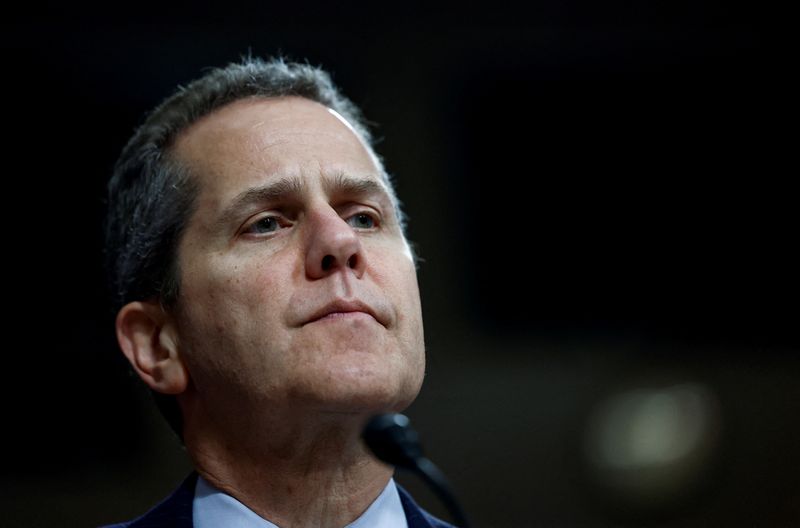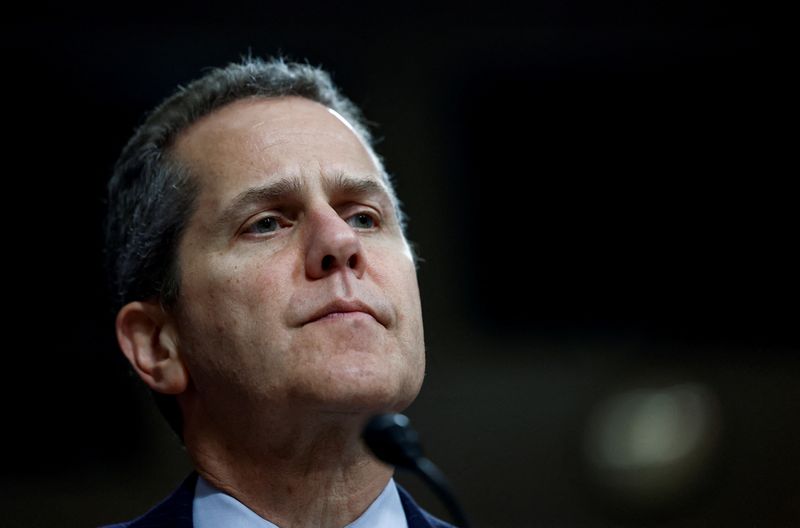
By Ann Saphir and Michael S. Derby
(Reuters) – Federal Reserve Vice Chair of Supervision Michael Barr’s decision on Monday to resign early from his regulatory oversight role sets up an early test of how Donald Trump will try to shape the U.S. central bank during his second term as president.
Barr said on Monday he plans to vacate his leadership role on the Fed’s Board of Governors on Feb. 28, but stay on as a governor, with a term that runs through January 2032.
The move leaves Trump no immediate opening to shape interest rate setting by nominating someone new to the Fed’s board. But it does give him the option to quickly elevate a current board member to run the Fed’s banking oversight function in a way more in line with his lighter-touch preferences, and avoids what could have been a disruptive legal showdown over political control of the role.
Barr is only the second person to be the Fed’s vice chair for supervision, a position created after the 2007-2009 financial crisis and the flurry of regulatory reform that followed.
“Regardless of whether or not this was a kowtow or for other reasons, this will likely be precedent-setting for how political the role of the vice chair for supervision is,” said Steven Kelly, associate director of research at the Yale School of Management’s Program on Financial Stability. “Barr stepping down likely means the role will continue to roll over with presidential administrations, much more like the other banking agencies’ leadership roles.”
Fed Governor Michelle Bowman, who has repeatedly staked out her opposition to Barr’s tougher regulatory approach, is a likely pick for his successor under the incoming Trump administration, analysts said.
At the same time, Barr’s decision to remain a Fed governor, which will see him continue to vote on interest rate decisions, may help fortify the central bank’s political independence as far as monetary policy goes, some observers said. Central bankers and economists generally view insulation from political sway on interest rate decisions to be critical to inflation-control efforts.
“The hypothesis that the Fed (Powell) is more willing to work with Republicans on regulation and supervision, as a way to preserve monetary policy independence, might have legs,” LH Meyer analyst Derek Tang wrote.
Fed Chair Jerome Powell’s role as the central bank’s chief does not end until 2026.
WHITE HOUSE INFLUENCE
Graham Steele, an academic fellow at Stanford Law School and former assistant secretary at the Treasury Department in the Biden administration, worries Barr’s move may create long-term issues for the central bank. Quitting the vice chair role now “sends the message that the Fed is not independent – either in the administrative agency sense or the central bank sense.”
“I imagine that the goal here was to avoid a legal and political fight, but it sets its own precedent about political control,” Steele said of the resignation. “The ones forcing the confrontation are the incoming administration and the banking industry, not Vice Chair Barr, who I think is right on the law.”
Barr has only infrequently remarked on monetary policy during his two and a half years at the Fed, but has always voted with Powell.
Trump railed frequently against Powell for rate decisions he disagreed with during his first term in the White House, and analysts have speculated on whether he would try to remove the Fed chief in an effort to exert control. Powell has said such a move would not be legal.
The president-elect’s advisors have been looking for ways to increase the White House’s influence over the Fed, including potentially removing Barr from his leadership role.
Any effort to do so “could also have set the precedent for a president to also fire the Fed’s chairman,” said Brian Gardner, chief Washington policy strategist at Stifel. “That issue has been averted for now.”

